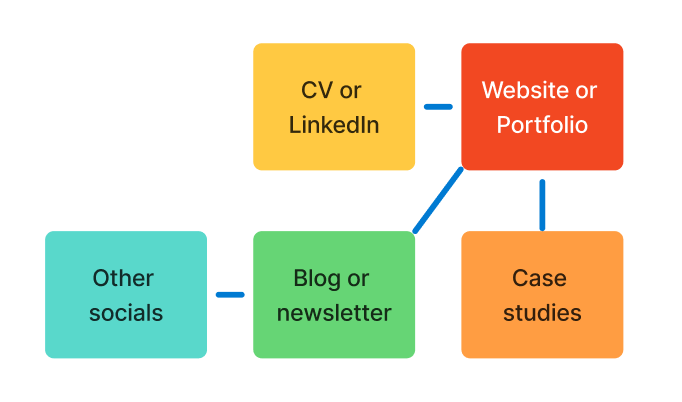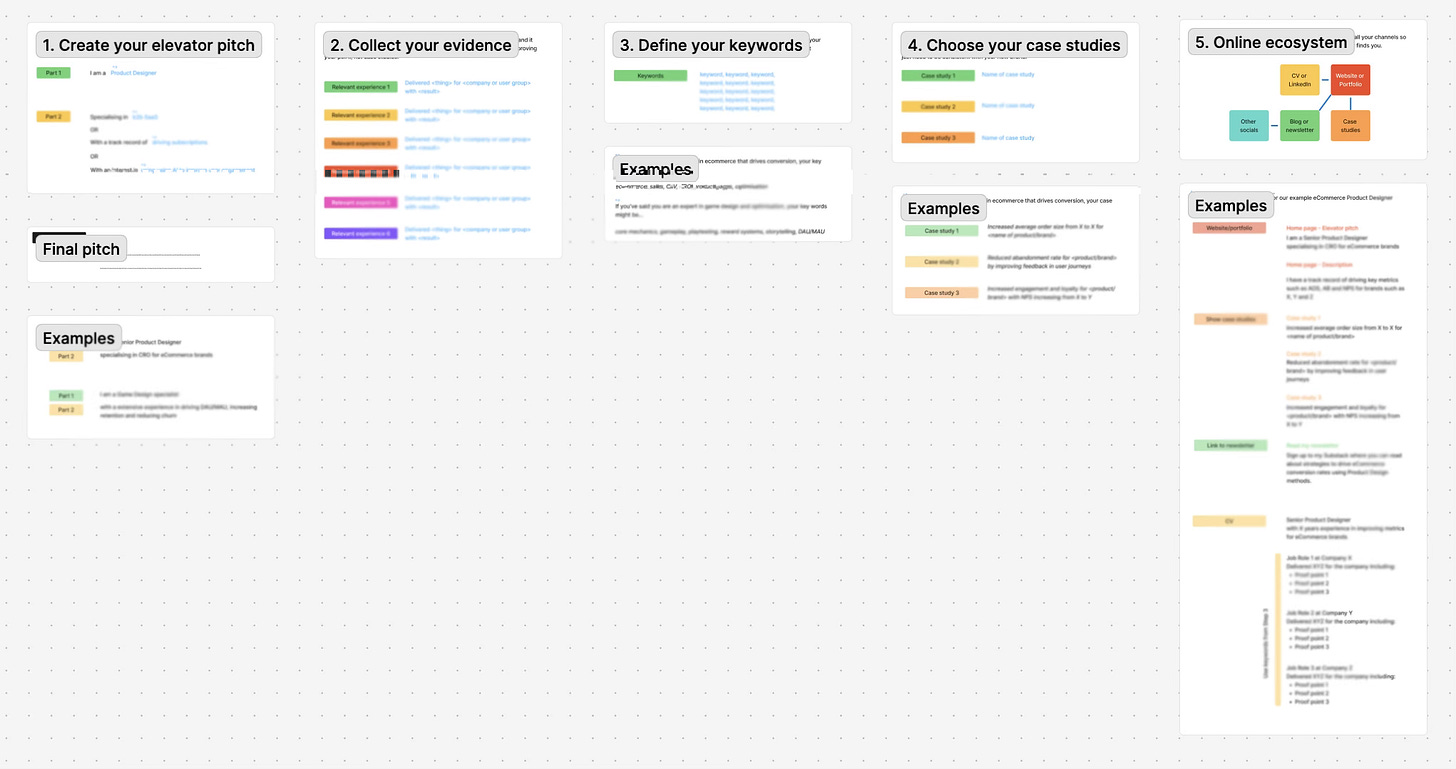Creating your 'brand' as a designer
How to clearly communicate and differentiate yourself as a designer, researcher or product person to get that job interview
🚨 Heads up - This post comes with templates. You can either buy them on Gumroad, or join this Substack as a paid subscriber to get all my templates free plus access the full 170+ article archive.
The following is based on a training/mentoring session I run with Designers, Researchers or Product people on the job hunt.
It shows you how to develop and communicate a clear proposition of yourself as a practitioner by using consistently designed brand messaging - so that recruiters and hiring managers understand you, see your fit, and want to get you in for an interview.
And it works. (I’ve used it on myself and many, many others).
Ready? let’s go.
1. Write your elevator pitch
The first thing we’re going to need to think about is your mission statement. You note I said ‘think about’. We’re not going to write it now. We’re going to think about what it is and needs to be.
🚨 Reminder - this is all in the template kit. Paid subscribers get all templates for free, plus access to the 170+ article archive here on Substack.
Your elevator pitch is the keystone to your entire brand as a designer. It reflects clearly who you are in a single statement, and everything else you produce - your portfolio, your CV, your LinkedIn, your blog posts, your socials.. have to back it up.
It is a two part statement. It is something along the lines of..
I am a <insert job title>
Specialising in <thing you are good at that is of value to a business>
It also needs to be something that is
True (in that you can evidence it without lying)
Something that you want to do as a job
Whatever you want your next job to be
For example, if you are a product designer who has worked on all sorts of things but really wants to do more eCommerce, then you are going to write something like:
I am a Product Designer
Specialising in eCommerce optimisation and driving sales
Just remember - you’re going to need to be able to back this up, so don’t go crazy. Which leads me to
2. Collect your evidence
The section above is the hardest bit. You might need to iterate it a few times before you’re comfortable with it. Also this next section might mean you have to change what it is..
You need evidence to support your elevator pitch in order for it to be true.
This isn’t case studies (at this point); this is just sentences that prove the claim above. Ideally a minimum of two scenarios from either paid work or side hustle or training project where you have done the thing you claim to be in your pitch.
You would phrase each one as something along the lines of:
Delivered <thing> for <company or user group> with <result>
Example for our eCommerce Product Designer:
Increased average order size from X to X for <name of product/brand>
Reduced abandonment rate for <product/brand> by improving feedback in user journeys
If you discover that you do not have the evidence to back up the elevator pitch, then you either need to adjust your elevator pitch until you can prove it, or go do some additional work (pro bono, speculative, whatever) to get the experience needed to make the claim.
Don’t lie.. recruiters and hiring managers will see through it and/or you’ll fall on your face in an interview which won’t be fun for anyone concerned.
3. Define your keywords
Now that you know what you are (or want to be going forward) and have some evidence statements to back it up, you’re going to want to make sure you stay on message - everywhere you are showing up.
To do this, you’re going to create a list of keywords that you can include in any and all content you create about your professional self from LinkedIn to portfolios to blogs.
They need to be keywords that are part of the work you describe above, that then ladders up to your Elevator pitch.
Example for our eCommerce Product Designer:
ecommerce, sales, CLV, CRO, product pages, optimisation
4. Choose your case studies
You can now choose your (max 3) case studies for your portfolio or website.
These need to be:
Matching your elevator pitch (e.g. 3x eCommerce case studies for our eCommerce Product Designer)
Aligned to your evidence (if possible directly matching the 3 pieces of evidence or along similar lines with measurable outcomes)
Using your keywords in the body of the case studies
5. Create your content ecosystem
And the final step is to roll this out across your content ecosystem.
Your ecosystem is made up of whatever online professional presence you have. The aim here is to make everything consistent, and therefore look credible and trustworthy and genuine.
So for each platform you will include your elevator pitch in some format, statements of evidence that back it up, case studies that align, blog articles that contain appropriate relevant content and all of it will link back to each other.
So that everywhere a recruiter searches for you, they get the same story.
You know who you are.
You can communicate who you are.
They can understand who you are.
They believe who you are.
They buy who you are.
Interview.
Want to see examples of how all this fits together and try it for yourself? You can get the Figjam template with examples to build your own professional brand messaging.
Paid subscribers get all templates for free plus access to my full 170+ article archive on Substack. The link for paid subscribers is right here
Keep reading with a 7-day free trial
Subscribe to It Depends... to keep reading this post and get 7 days of free access to the full post archives.






